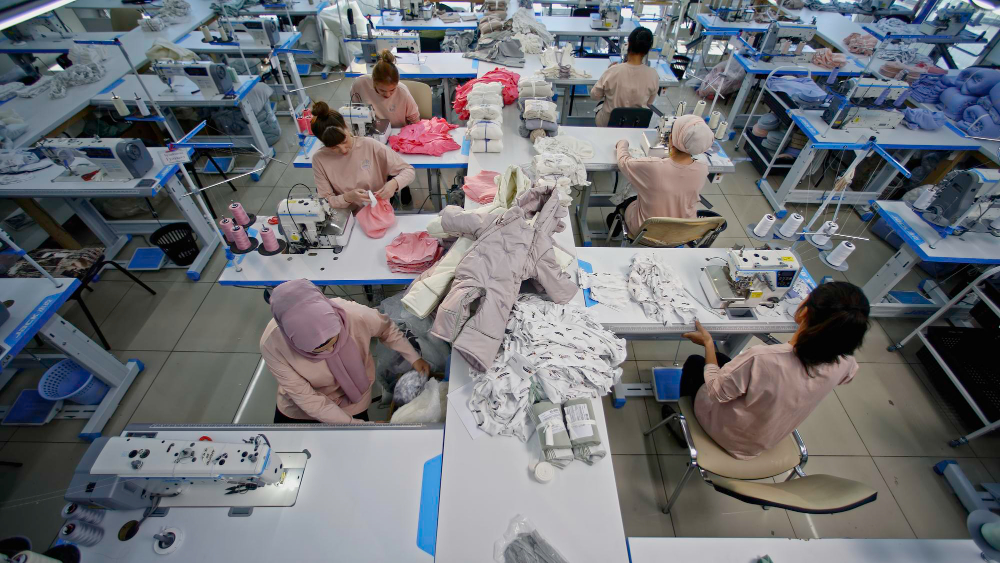Summary
- The garment industry moves fast. It connects trends, people, and markets around the world.
- But behind the scenes, it also faces serious challenges, from rising costs to global competition.
- Overcome industry hurdles with the power of fashion technology. Try Audaces360 for free!
As competition between countries grows, many factors are putting more pressure on businesses. Add to that the growing demand for speed and sustainability, and the path forward becomes even more complex.
Small brands and large manufacturers alike must adapt to survive. Change is not just an option, it’s a need, and knowing where to start can be hard.
This article looks at the key challenges shaping the garment industry today. But don’t worry, we won’t just list problems. We’ll guide you through each issue and hint at possible solutions.
Enjoy the read!
Sumário
What is the importance of the garment industry?
The garment industry plays a key role in the global economy. It produces the clothes people wear and creates jobs around the world. In many countries, it is one of the biggest sources of industrial employment.
From factories to design studios, millions of people work in this field. That’s why it also plays a role in the labor movement. People in this sector have fought for better working conditions, fair pay, and safety. Their efforts have shaped labor laws around the world.
Moreover, the clothing industry connects to global trade. It depends on materials and professionals from many places, forming a large and complex supply chain.
Beyond following fashion trends, it must adapt fast to what people want. This pushes companies to be quick, creative, and ready for change.
In short, the garment industry helps drive economies, shapes culture, and connects global markets.
Learn more: What is the fashion industry, its value, and key players?
What’s the difference between the garment industry and the textile industry?
The textile industry makes raw materials, producing fabric, yarn, and threads. These materials feed other sectors, including the garment factories.
The garment industry, on the other hand, turns fabric into finished clothes. It includes cutting, sewing, and adding labels or buttons.
You can think of the textile industry as the first step. It creates the base materials. The garment production process comes later, closer to the final customer.
The garment sector also works on style and fit. It follows fashion and creates different designs. This part of the work often takes place in cities, near designers and brands.
In factories, clothes undergo an assembly line. Each worker does one task, like stitching sleeves or adding zippers. This method helps speed up production and keep costs low.
The two industries started to separate in the early 20th century. As machines and global trade grew, they became more specialized. Today, they work together, but serve different parts of the process.
Explore the global landscape of the garment industry

Americas
The Americas show a diverse picture of the garment industry. North America focuses more on design, marketing, and high-end production. Meanwhile, countries in Central and South America are strong in manufacturing and export.
In the United States, most clothing brands outsource production overseas. However, there is growing interest in local manufacturing, especially for sustainable and custom-made fashion. Technology and automation are actually helping bring some jobs back.
Countries like Mexico, Colombia, and Brazil play key roles in regional production. They benefit from trade agreements and lower labor costs. Many brands use them as nearshoring options to reduce lead times.
The region still faces challenges like high competition and rising costs. Yet, innovation, proximity to large markets, and skilled labor continue to drive growth in many areas.
Learn more: How United States industrial production shaped fashion
Europe
Europe has a long history in fashion and garment production. Today, it remains a global leader in design, luxury, and sustainability. Countries like Italy and France are famous for high-quality craftsmanship and iconic brands.
Eastern Europe, on the other hand, is strong in manufacturing. Nations like Romania, Bulgaria, and Poland offer skilled labor and fast delivery to Western markets.
The European Union promotes fair labor and green practices, such as the adoption of the digital product passport. Today, many companies are investing in eco-friendly materials and ethical supply chains. This reflects strong consumer demand for responsible fashion.
Learn more: 5 reasons why fashion houses should innovate with quality
Africa
Countries like Ethiopia, Kenya, and Egypt are attracting global brands with low production costs and growing infrastructure.
These governments are investing in textile parks and industrial zones, aiming to create jobs, boost exports, and support economies. Some regions even offer tax breaks and trade benefits to attract investors.
The industry is also a tool for development. It provides work for young people and women, helping reduce poverty and support economic growth.
However, challenges remain. These include limited access to technology, unstable power supplies, and gaps in skills.
Still, with the right support, Africa has great potential in the global garment market.
Asia
Asia is the heart of global garment production. It leads in both volume and exports, supplying clothes to major brands worldwide. The region is home to some of the world’s top garment manufacturers and exporters.
Bangladesh garment manufacturers are famous for large-scale production at competitive prices. The country is the second-largest apparel exporter after China. Its industry supports millions of workers and is vital to its economy.
Countries like Vietnam, India, and Indonesia also play major roles. They combine low costs with growing expertise in design and technology. Meanwhile, Hong Kong serves as a global hub for fashion sourcing and logistics.
Asia’s strength lies in scale, speed, and adaptability. But the region must also address labor issues and increase focus on sustainability to meet future demands.
Want to take your company to the next level and reach peak productivity? Download our free exclusive guide filled with golden tips to get you there!
The 5 main challenges in the garment industry

1) Productivity
Low productivity is a common issue in the garment industry. Many factories still rely on manual tasks and outdated systems. This slows down production and increases the chance of mistakes.
Skilled labor shortages also impact performance. Without proper training and modern tools, teams can’t keep up with demand. Companies lose time in inefficient processes and rework.
Solution: To improve productivity, companies can adopt digital tools and automation. Technologies like CAD systems, marker optimization, and production planning software help speed up work, reduce waste, and increase accuracy.
2) Sustainability
The garment industry has a major impact on the environment. It uses large amounts of water, energy, and chemicals, turning waste and pollution into major concerns.
Fast fashion makes the problem worse. It pushes brands to produce more, faster, and at lower costs. This often leads to poor quality and large amounts of discarded clothing.
Consumers and governments are now demanding change. However, companies that fail to act face damage to their image and possible legal risks.
Solution: A sustainable approach involves better material choices, cleaner processes, and waste reduction. Digital solutions can also help by reducing fabric waste, enabling better planning, and supporting eco-friendly decision-making.
Learn more: Find out how fast fashion and sustainability can coexist in the apparel industry
3) Rising raw material and dollar costs
Fluctuations in the cost of raw materials directly impact the garment industry. Cotton, polyester, dyes, and packaging materials have all seen price hikes in recent years.
The value of the dollar also plays a role. For companies that rely on imports or exports, changes in exchange rates can cut into profits or raise prices.
These cost increases are hard to predict and harder to control. Small and medium companies are especially vulnerable, as they have limited bargaining power.
Solution: To manage costs, companies can invest in better planning and resource management tools. Using digital platforms helps track expenses, leading to more stable margins even during price swings.
4) Changing consumer behavior
Today’s consumer expects more. People want faster deliveries, more choices, and ethical practices. They’re also more informed and willing to switch brands quickly.
Trends shift fast, and social media drives much of this change. To remain relevant, brands must react quickly, as traditional methods can’t keep up with this pace.
There’s also a growing demand for personalization. Consumers want clothes that reflect their style and values, pushing brands to rethink how they design and produce.
Solution: Technology helps companies respond to change. Tools for virtual prototyping and on-demand production can help brands move faster and meet customer needs.
Learn more: Top 5 technologies driving mass customization in clothing
5) Creativity and innovation
In a competitive market, creativity sets brands apart. But coming up with fresh ideas regularly is a big challenge. It’s even harder that design teams often work under tight deadlines and limited resources.
Innovation also involves new materials and technologies. However, not all companies can afford the risk or the investment. This slows progress and limits what smaller brands can offer.
At the same time, copycat fashion and fast production cycles can discourage original design. Teams must often follow trends instead of leading them.
Solution: Investing in digital design solutions and 3D software allows teams to explore ideas quickly and efficiently. These tools support faster testing, better visualization, and stronger collaboration, unlocking the full potential of creative teams.
Learn more: Discover 5 major benefits of 3D simulation for fashion
Boost your garment industry’s performance in the age of Industry 4.0
Learn how Audaces solutions support every stage of the garment industry!
Audaces360
Audaces360 integrates cutting-edge digital innovations to optimize workflows in the textile and apparel industry.
It caters to companies of all sizes and types, offering the flexibility to scale with your business needs.
All solutions were carefully developed to address the specific challenges of the field. They streamline the design and production processes, saving valuable time and resources.
The platform boasts a comprehensive range of functionalities, including pattern making, marking, collection management, vector drawing, and 3D creation.
In addition, a fashion Artificial Intelligence to assist you along the way.
Audaces Cutting Room
By embracing cutting-edge technology, garment manufacturers can achieve significant improvements in the production process. From greater design flexibility to enhanced efficiency and reduced costs.
This is where Audaces Cutting Room steps in! Our experts will thoroughly assess your company’s needs and create a comprehensive report.
Then, our team will develop a personalized project to achieve your goals and unlock your company’s full potential.
Rely on Audaces’ cutting-edge machinery to automate your production process. Achieve impeccable cuts on curves and details, speeding up your deliveries and minimizing fabric waste through automation.
Want to stay up to date on the latest fashion industry news? Subscribe to our newsletter!
FAQ
The garment industry plays a key role in the global economy. It produces the clothes people wear and creates jobs around the world. In many countries, it is one of the biggest sources of industrial employment.
The textile industry makes raw materials, producing fabric, yarn, and threads. The garment industry, on the other hand, turns fabric into finished clothes.
Some of the main challenges include productivity, sustainability, rising costs, changing consumer behavior, creativity, and innovation.





